Life After Stroke- How To Stay Safe At Home After A Stroke

More than ten years ago, my father-in-law suffered from a massive stroke. He was rushed to the emergency room in the wee hours of the morning and stayed in the hospital for three weeks. From that moment on until he passed away four years later, life was never the same for him again.
Stroke comes like a thief in the night- one day you’re feeling completely normal, and the next- you can barely talk, move one side of your body, or even feed and bathe yourself properly. More often than not, the patient and his / her family members are at a loss on what to do next.
- What happens when the stroke patient gets discharged from the hospital?
- What lifestyle changes do you need to make?
- How do you adapt your home for the stroke patient’s safety?
- How can you make everyday life and movement easier for your loved one?
- How can you improve the quality of life via important home adjustments, after you or a loved one suffers from a stroke?
With the help of friends from March of Dimes– After Stroke BC, we created this article to help stroke survivors and their caregivers navigate through these uncertain times.
First of all, let us assure you: there is life after a stroke. It might be harder, or more challenging, but with the right steps and support- you can still have a successful and comfortable quality of life.
WHAT IS A STROKE?
Stroke affects the arteries leading to and within the brain, causing the sudden loss of brain function. It is primarily caused by:
- Blocked blood flow to the brain (ischemic stroke)
- A ruptured blood vessel (hemorrhagic stroke)
When blood is blocked from getting to your brain or there is bleeding in the brain, the brain cells do not get the needed oxygen- which causes them to stop working properly or die.
STROKE IN CANADA
In Canada, stroke is the number one cause of disability among adults and the third leading cause of death. Every year, Canada reports more than 50,000 new stroke cases (one every 10 minutes) and almost 14,000 Canadians die from stroke.
- A stroke occurs equally between men and women. The rate of the first stroke is higher among men, while more women have a stroke each year compared to men, partly due to women having a longer life expectancy.
- Men aged 60 and over have consistently higher occurrences of stroke than women of the same age group.
- There are more male stroke survivors between the ages of 50 and 79, while the number of female stroke survivors aged 80 and above exceeds that of men.
- Good news: there is a steady decline seen in first stroke and all-cause mortality rates in recent years. This could be due to raised awareness, better stroke care, and improvements in managing risk factors earlier on.
(Source: Stroke in Canada: Highlights from the Canadian Chronic Disease Surveillance System)
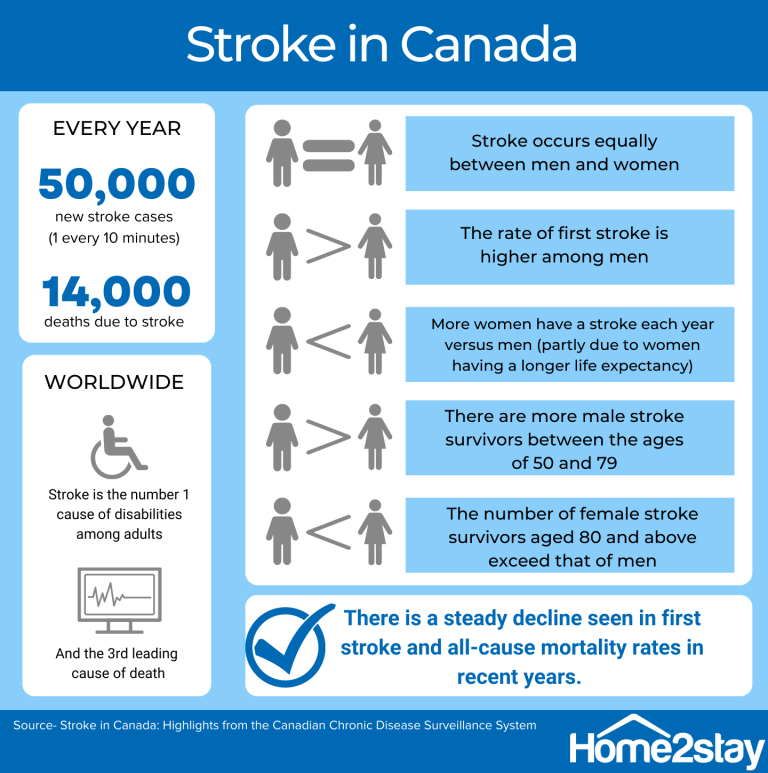
WHAT TO EXPECT
Accept that life after a stroke will be different. When a person suffers a stroke, it’s like the brain has been reset and the patient would have to re-learn how to do simple daily tasks such as eating, talking, walking, bathing, etc.
Performing everyday activities will be more challenging due to the sudden onset of symptoms such as weakness or loss of sensation, coordination, and balance (most often on one side of the body), speech and vision difficulties, headaches, and feelings of confusion.
These symptoms and complications of stroke can persist and affect the quality of life.
Re-learning how to accomplish tasks is best done via repetition– through repeating information, consistent use of motor skills, and employing the same way of doing things every day.
- Build a daily and weekly routine.
- The stroke survivor and caregivers need to learn to adapt and shift from the old ways of doing things.
- Help the stroke survivor do things the same (adapted) way consistently every time.
Remember that trial and error is part of the process- do not be discouraged when something does not work. With time, encouragement, and proper support, the stroke patient can eventually learn how to do simple tasks independently.
Preparing the home for stroke survivors
We recommend consulting with an occupational therapist (OT) and a home accessibility and universal design specialist before the patient gets discharged from the hospital. It is best to get your home set up with accessibility and mobility solutions, in preparation for the patient’s return.
In Home2stay, we have assisted countless families to ensure that stroke survivors can stay comfortably and safely at home.
Every space and situation is different and we advise getting customized recommendations from your OT & home accessibility team. But generally, these are the helpful tools that can make your home easier to navigate post-stroke:
- Entrance and Exit
Getting into and out of the house can be a problem, especially if there are steps leading up to your entry or exit points. What you can have installed to make your entryways more accessible to wheelchair users or individuals with mobility challenges: portable ramps, vertical platform lifts (VPL), stair lifts, or residential elevators.
The portable ramp is the cheapest alternative among the three, though it is limited to a maximum rise of 30 inches (760mm) and a maximum horizontal run is 30 feet (9m). There are two kinds of portable ramps: modular and folding ramps. A portable ramp works best with handrails on one or both sides for added support and safety.
A modular or folding ramp is more practical compared to a permanent ramp, as you can fold or roll it up when not needed, and in most cases, you do not have to get a permit for its installation, since it is not a permanent fixture.
To navigate a porch staircase that runs a greater distance, you need a VPL, stairlift, or residential elevator. Make sure to get these installed by an authorized distributor/installer only, so that you will not void the limited lifetime warranty. An authorized installer will also provide training on how to properly operate the mechanical equipment after installation and conduct the annual preventive maintenance to ensure that your accessibility solution functions for many years.
Other considerations in choosing the right equipment for yourself and your loved one are your budgets, ease of use, the size of your space, how frequently you expect to use the equipment, and its durability versus harsh outdoor elements.
For easier navigation for wheelchair or scooter users, doorway or entry openings should provide a clear width of 32 inches (815mm) minimum. A no-step entry is best for accessibility- and a threshold ramp would often do the trick for one elevated step or uneven surface between the porch and the doorway. Take it a step further by installing sturdy handrails or grab bars on the wall beside your doorway.
Using the traditional round door knob and the key latch is challenging for those with loss of muscle and hand strength, so it’s a good idea to replace these with lever door handles and keyless control systems (digital code keypad or access that can be synced to a smartphone).
The handles, latches, pulls, and locks should be placed between 34 inches (865mm) to 48 inches (1220mm) from the ground or floor. This should apply to all doors, both on the exterior and interior of the home.
- Bathroom
Depending on the severity of the stroke and its effect on muscle/balance control of the patient, enjoying private time in the bathroom may have to be relinquished temporarily, when the patient comes home from the hospital.
Most accidents occur in the bathroom, so this area in your home needs special preparation and attention.
The first thing you need to check is your shower/bath:
- Stepping over the high wall of the bathtub is a major fall risk for stroke survivors. A cost-efficient option to minimize this risk is to convert your bathtub into a step-in shower or bath by having a home accessibility expert do a tub cut out on your existing tub.
Or if you have the budget, you can opt for walk-in tub installation- many models already come equipped with therapeutic features such as air, hydro, and micro bubble therapy to soothe post-stroke pain such as aching joints and muscles.
Home2stay’s barrier-free bathroom line includes portable accessible shower bays- that can be placed in any room in your home; modular barrier-free shower sets, and the European wet room conversion kits.
- In case you would rather maintain your existing tub, you may use a transfer bench instead. This allows users to enter the bathtub by lowering themselves gently from a sitting position- so there will be no need to lift one leg to step over the bathtub wall.
To minimize the time spent standing up in the bathroom for stroke survivors, place several shower seats or bath chairs in the shower area, as well as other areas around the bathroom, such as in front of the sink or where people dress / undress or where they wipe themselves with a towel.
- Get a handheld shower that comes with a longer hose and weighs lighter, since a stroke survivor would probably have a weaker hand grip and limb control and would need to take a shower while sitting down.
Other things you need for a safe and accessible bathroom for a stroke survivor:
- Grab bars are a must-have in any safe and accessible bathroom! And why not? They are simple to install, affordable, and come in all styles and sizes.
Grab bars should be placed on the bathtub/shower area, toilet area, and anywhere support is needed.
In the bathtub/shower area, there should be grab bars vertically on the bath entrance (where people stand to step into the bath or shower area), horizontally on the side walls, beside the faucet and control handles.
Grab bars should be placed between 33 to 36 inches from the floor, according to the Americans with Disabilities Act (ADA) guidelines.
In the toilet area, the purpose of grab bars or support rails is to support the transition from sitting to standing and vice versa and to help provide balance, in case the stroke patient feels dizzy or weak while using the toilet.
Options for support in the toilet area:
▢ Grab bars should be placed on one or two walls beside the toilet.
▢ In the absence of walls, you can install toilet safety rails on both sides of the toilet.
▢ A floor-to-ceiling support pole like the SuperPole with SuperBar, or a floor-mounted rail like the Advantage Rail, provides vertical and horizontal support and is ideal for smaller spaces.
- A raised toilet seat or a commode toilet chair will help a stroke patient get on and off the toilet more comfortably and safely. The upper part of the toilet seat should be between 17 to 19 inches above the floor.
- Non-slip bath mat in the tub and shower area, or any floor area that gets wet frequently.
Choose floor mats with rubberized backing (this provides traction and prevents the mat from becoming slippery when wet), made of anti-bacterial and BPA-free materials, easy to clean, thinner, and do not flip up at the edges. Be sure to replace your floor mats at least once every year, as the backing will wear out over time and will not be able to stick securely to the floor with long- term use.
Instead of floor mats, you can also opt for non-slip strips, treads, or decals.
- A warm bath or shower is beneficial in keeping stroke survivors relaxed and can alleviate their body pains temporarily. However, difficulty in maneuvering water temperature controls can lead to burns and scalds.
It is recommended to have a thermometer ready or to install an anti-scald temperature controller in the shower, tub and sink.
- Make use of big handles and user-friendly controls, such as blade, lever handles, or motion control technology.
- Small tools and changes can make everyday bathroom activities easier to accomplish:
- Electric toothbrush with a large handle
- Electric shaver
- Automatic squeezer for toothpaste
- Long-handled sponges and shower brushes can help someone with a limited range of motion in the shoulder, elbows, and wrists to clean hard-to-reach body parts.
- A toileting/wiping aid that holds the tissue paper for wiping the bottom
- Hair dryer stand for hands-free drying, curling, and styling
- Hallways and Stairways
Staircases may be the biggest hurdle in the home after a stroke. Every step presents a challenge to someone with limited mobility and balance.
Let’s discuss stair lifts, VPLs, and residential elevators further here. They are all mechanical equipment that can help you navigate vertical distances safely and conveniently.
Vertical porch lifts (VPL) and residential elevators are usually made for two-story spaces, with a travel distance of up to 14 feet. Straight stair lifts can cover as long as 30 feet in distance, while curved stair lifts can be customized according to the length of your staircase.
The VPL and curved stairlift can be used both indoors and outdoors, and are made to withstand harsh weather conditions, so they are good choices for the porch area.
Wheelchair and mobility device users can directly enter the VPL or residential elevator with no need to stand up / transfer from their wheelchair to another seat, whereas stair lifts require the user to alight from his / her mobility device and transfer to the seat and vice versa.
While modern stair lifts, VPLs, and elevators are designed with the user’s needs in mind and are easy to operate, it is always best to get these machines from authorized installers and distributors, who can train you or your caregiver on the proper use of the equipment and can conduct repairs and scheduled maintenance to ensure that they function properly and safely for many years to come.
Apart from stairways, handrails can also be installed along long hallways and on the walls in any room in your home. Home2stay is a certified installer of Promenaid, the world’s first ADA code-compliant continuous handrail system, which can be customized to your specific needs and space requirements.
These installations can make the stroke survivor’s life and everyday tasks easier, but apart from these, there are additional cost-efficient things you can do to make your home safer:
- Since a stroke survivor might have a hard time lifting his legs and feet properly- Get rid of clutter on the floor and other objects/decorations that can hinder the person’s path while walking. Keep electrical cords and pieces of furniture out of the way.
- If you should use rugs in your home, select those with non-skid backing or secure the bottom part with double-sided tape.
- Bedroom
It’s important to ensure that the stroke patient will be safe when he/she wakes up in the middle of the night, so keep these within easy reach from the bed:
- Source of adequate lighting- light switch, flashlight, or motion sensor light.
- A way to call for help- telephone, mobile phone, or a wearable device with communication/alarm features.
- Getting to and from the bathroom at night is difficult, especially when the person is still getting used to re-learning how to perform his regular activities, so consider placing a commode chair near the bed to avoid risky night movement around the house.
- A bed rail, such as the Healthcraft Smart-Rail, can support movements on the bed, transitions to and from the bed (lying down / sitting to standing and vice versa)- it swings open to provide additional standing support and can be adjusted to your height.
- Other installations that can provide vertical and horizontal bed-side support, while not consuming much space, include the floor-to-ceiling SuperPole and the floor-mounted Advantage Rail.
Other helpful objects to have in the bedroom:
- Waterproof pads underneath the bed sheets, since the nerves that control urinary function might be damaged after a stroke, leading to frequent urination, urinary incontinence, and urgency.
- An egg-crate foam on the bed will add comfort for individuals who are bed-ridden or have to stay lying down for long periods.
- Tools that make getting dressed easier: reacher, button hook, sock aid, shoe horn, etc. A zipper pull can also be attached to any zipper, to increase the area available to grasp and makes it easier to zip up clothes.
For stroke cases wherein the mobility of the patient is seriously challenged, consider getting a patient lift, such as a ceiling track lift or a portable lift, to help transport the individual safely from the bed to a wheelchair or other areas of the room. (A patient lift can be installed in any room in your home.)
- Dining Room and Kitchen
Daily eating might be a challenge for stroke survivors since they can only use one hand in feeding themselves- this can lead to dinnerware accidentally falling from the table, food sliding off the plate, difficulty in grasping silverware, and slicing food to bite-sized pieces, and drinking from a cup.
The following can make dining more comfortable for the stroke patient:
- Silverware with larger handles, rubber grip handles, or finger loops.
- Plate guards or food bumpers to keep food inside the plate
- Adapted dining plates and bowls with added weight or non-skid bottoms to keep them from falling off the table
- Non-slip mats or damp washcloths under the plate or bowl will also hinder it from sliding around
- Drinking cups/bottles with lid and straw
- Dining chairs with extra cushion and back support- providing the right height/position for the stroke patient. A wheelchair user will need a dining table or kitchen counter that is adjusted to the optimal height.
Make sure to slice food into small bite-size pieces or stick to softer food such as soups, porridge, mashed potatoes, cooked cereals, applesauce, etc. A blender or food processor is a big help in food preparation for stroke patients.
Other adjustments you can make in the dining room and kitchen are:
- Shift to adaptive kitchen aids and tools such as one-handed, non-skid cutting boards, rocker knives, and self-stirring mugs- choose ones with large handles and are easy to grip.
- Pick the right appliances and equipment- invest in smart appliances, automatic kitchen equipment, or those that can be controlled by remote control or a smartphone.
- Always have a fire extinguisher ready within easy reach.
- Put ingredients, food items, and tools on counters and cabinets that are accessible to someone using a wheelchair, mobility scooter, or walker.
General Home Guidelines For Stroke Patients
We’ve discussed what to do in each room in your home. Now, let’s break down the steps that apply to any area in your home, to make it truly accessible and safe for someone with mobility challenges.
- Adequate spaces- especially for someone in a mobility device, such as a wheelchair or scooter, or using an aid such as a walker or cane.
○ The doorway should have a minimum opening of 32 inches.
○ A clear space with at least 60 inches radius to turn the wheelchair around (this can be space under the tables/counters- just make sure that the knees of the wheelchair user will not hit any surfaces).
○ Get rid of clutter and keep your space clean and organized.
- There should be enough lighting in every area.
○ The use of adjustable lights is the best way to accommodate the different levels of light sensitivity of every individual.
○ Motion sensor lights will detect movement and require no touch to operate, making them friendly to those with mobility issues.
○ Rocker or paddle light switches are wider in size, making them easier to use for someone with unsteady hands.
- Make use of technology
○ Smart appliances and equipment that work with a remote controller, smartphone and wifi, or appliances with automatic timers and functions:






○ There’s an app for basically everything now and these are some of the apps which are especially useful for stroke survivors:






- Grab bars, safety poles and handrails are your friends. They are not just for the bathroom- but they provide effective and affordable support anywhere in your home. Place them anywhere the stroke survivor might need extra support:
○ Areas where the floor is prone to get wet such as the kitchen, laundry area, garage, entrance, and exit points, etc.
○ Where the stroke survivor usually transitions from standing to sitting and vice versa, such as near the couch, at the work desk, near the bed, etc.
- A step stool or reacher is useful in helping the stroke survivor reach for things without the need to bend down or stretch his / her arms towards high shelves or overhead cabinets.
- Put visual aids and organize everything properly- it will be a challenge for stroke survivors to remember things and one of the best ways to help them is to have a designated place for everything.
Again, it’s all about building the proper routine for them.
○ Keep things in accessible containers and put clear labels:
▪ Medicines and vitamins (include instructions on dosage quantities and schedule)
▪ Food items and ingredients (transfer to easy-to-open containers, label properly, including expiration dates)
○ Use cord organizers to avoid jumbled wires and make sure that phone chargers and batteries are within reach.
○ Set up emergency contacts on the phone for quick calling- make a list of important names and phone numbers and put them on several areas of the house- on the refrigerator door, beside the phone, in the living room, on the bedside table, on the bathroom counter, etc.
- Have a book, phone, or tablet stand ready, so the stroke patient can read or use his / her devices without the need to hold them with two hands.
- Hand grip tools or squeeze balls can help with hand recovery after a stroke and it’s a good idea to have them around in areas around your home, so the stroke survivor will remember to do hand therapy exercises consistently.
An encouraging quote from Flint Rehab states:
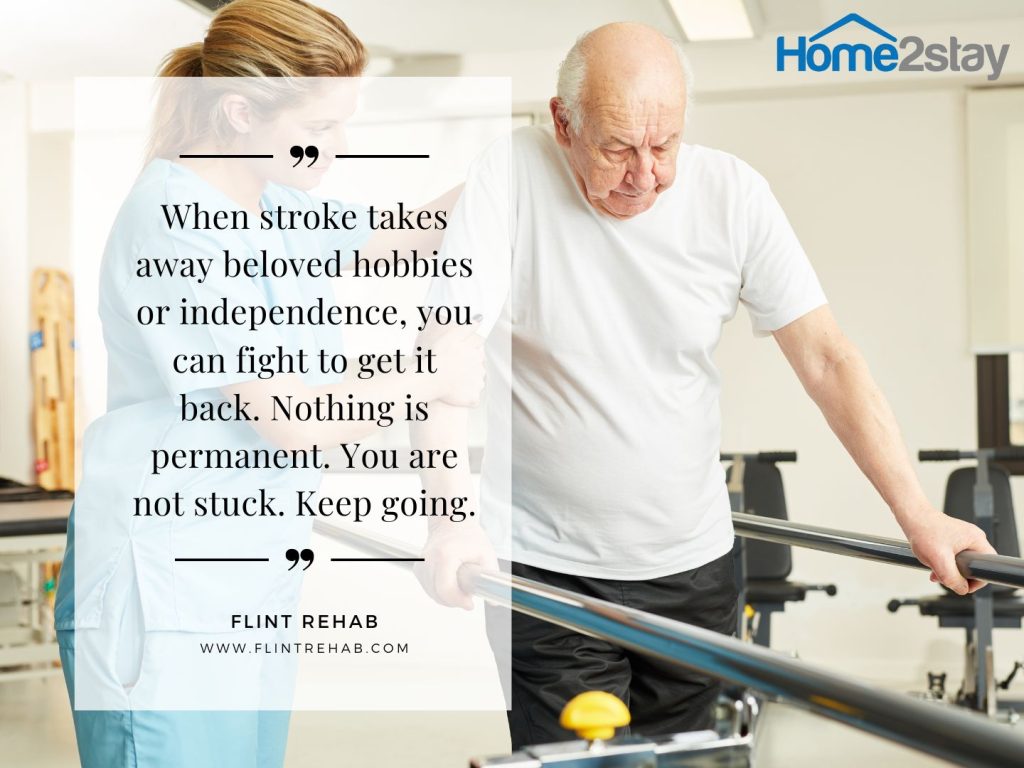
What is important is that you make the decision to do your best to learn and relearn new habits and create new ways of doing things, no matter how challenging it may be.
And remember that the human connection matters- a lot! Surround yourself or your loved one with the right people to support with recovery or improve the quality of life after a stroke:
- An Occupational Therapist (find qualified OTs in British Columbia here)- he/she would help you improve your sensory and motor skills after a stroke.
- A home universal design and accessibility solutions provider- our team at Home2stay has assisted numerous stroke survivors with their home adaptations after a stroke. We conduct FREE in-home assessments and provide customized recommendations for your unique space and needs.
- A group of fellow stroke survivors that you can find in your local community or online- listen to their success stories, learn from one another, and have a team who cheers on your progress.
- Follow and read resources from stroke support organizations, such as the Stroke Recovery Association of BC– to learn more about your condition and discover the innovations that can help your road to recovery.
- Family and friends who provide love, kindness, and encouragement- messages, calls, and visits can go a long way in giving hope to stroke patients and their caregivers.
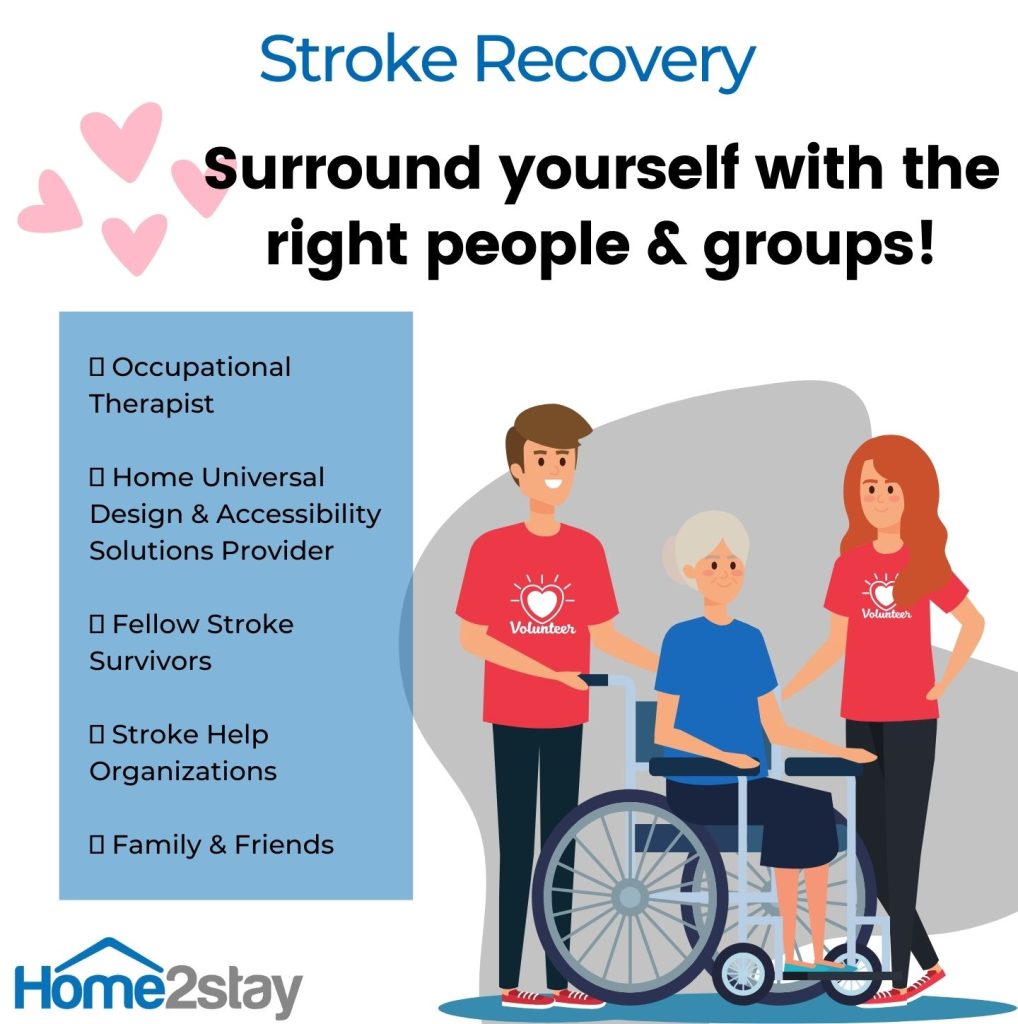
You can get through this challenging period. Take it one day, one step at a time. When you get tired, rest- but never give up!
Leave the home modifications to us at Home2stay and we’ll transform your home into a safe space for yourself and your loved ones. We have been helping stroke survivors and their family members in the British Columbia region with their accessibility solutions for almost a decade.
Give us a call at (604) 259-1211 or send us a FREE ASSESSMENT REQUEST form and we’ll help you or your loved ones stay and live safely at home after a stroke.
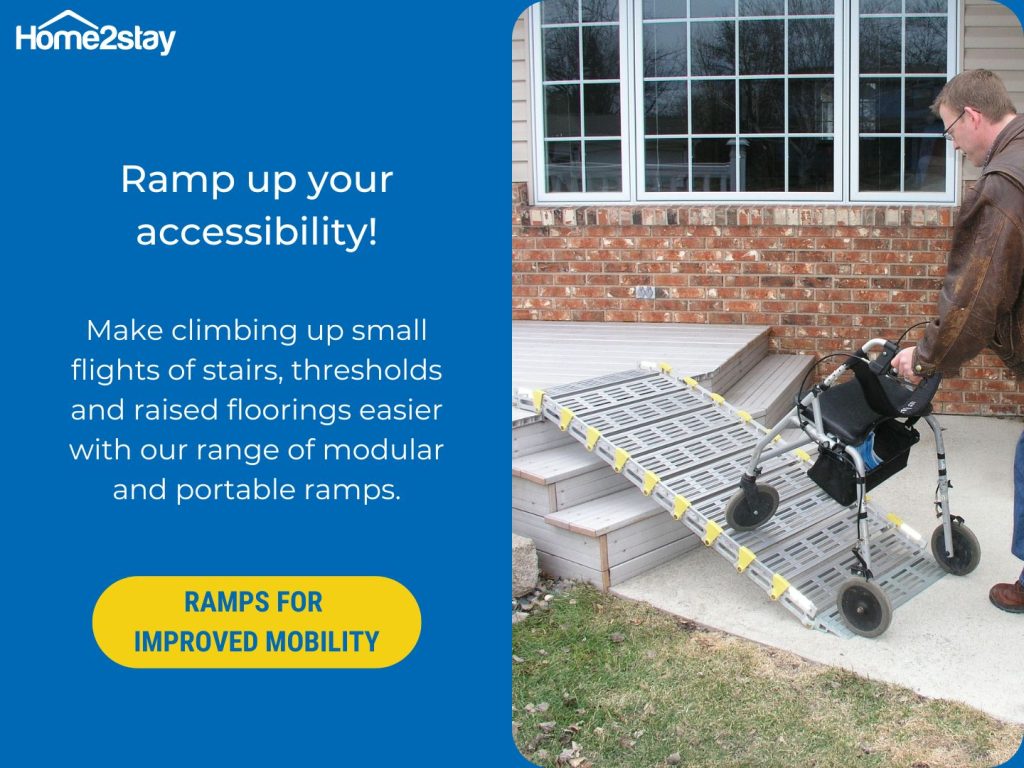
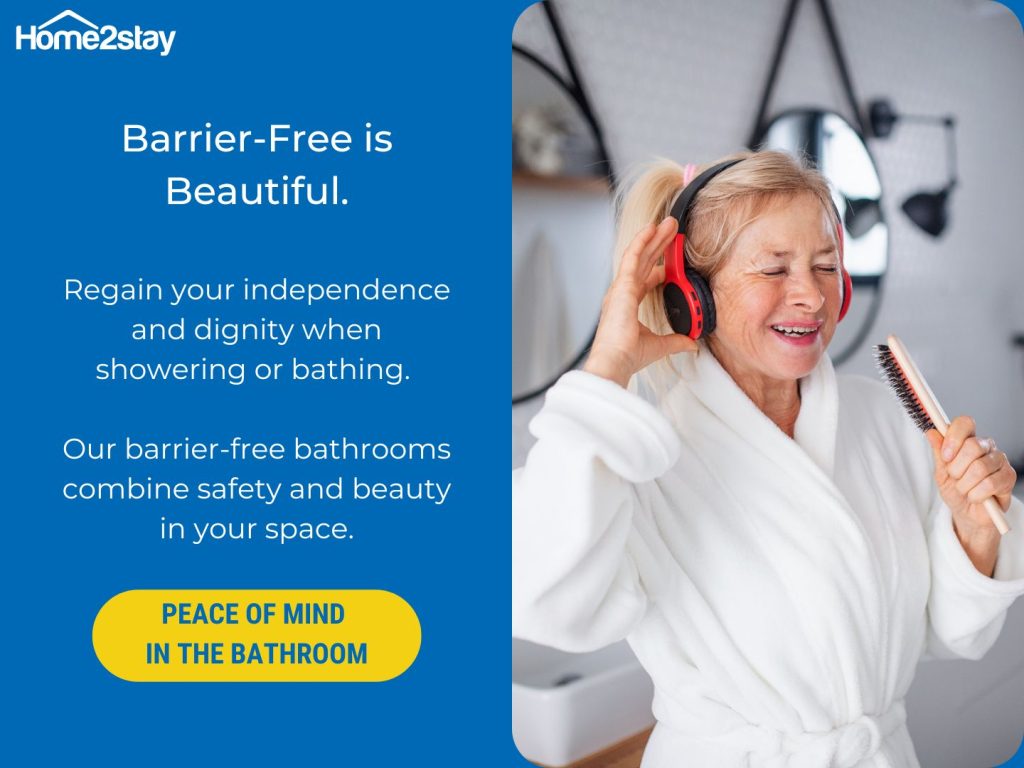
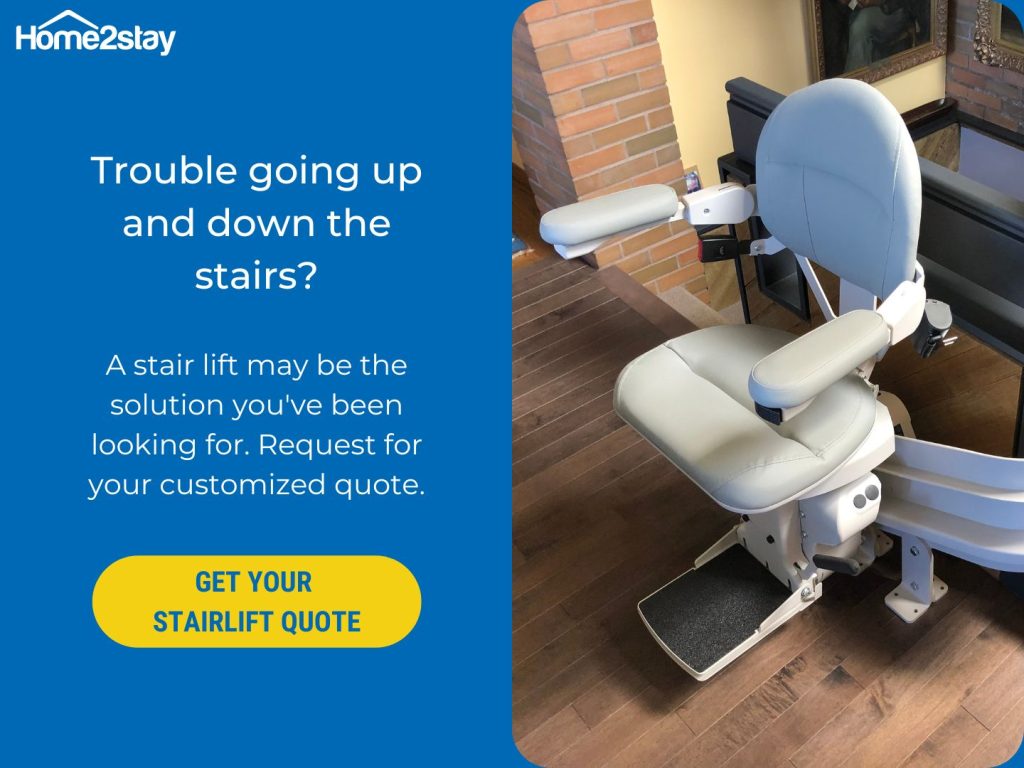
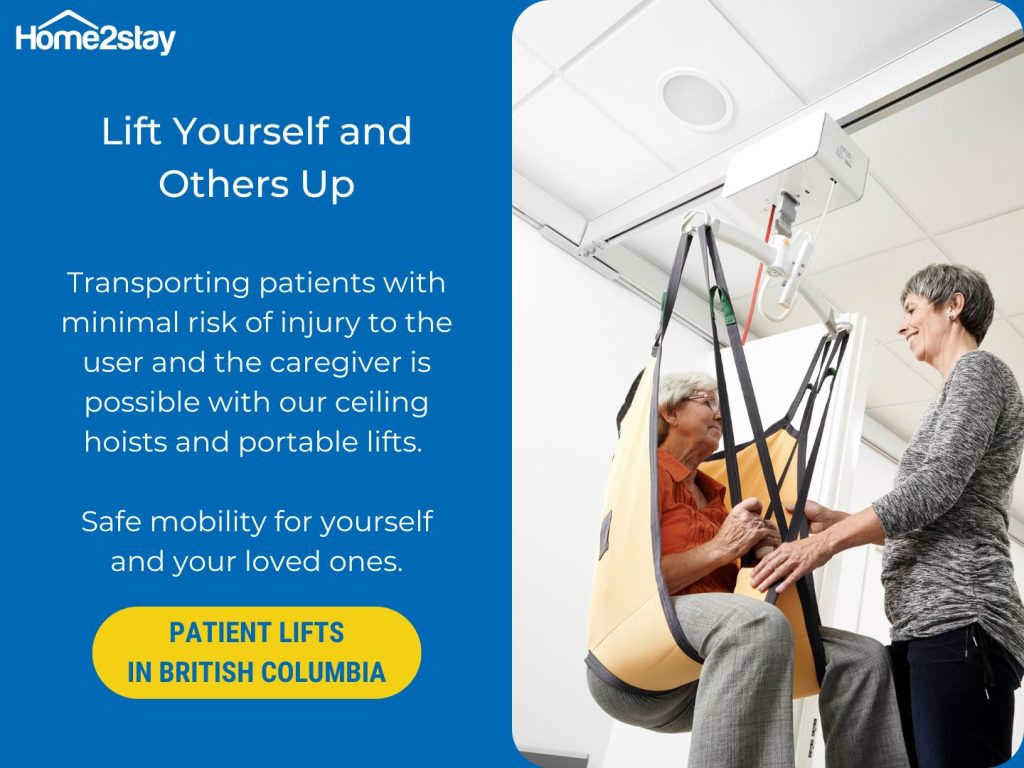
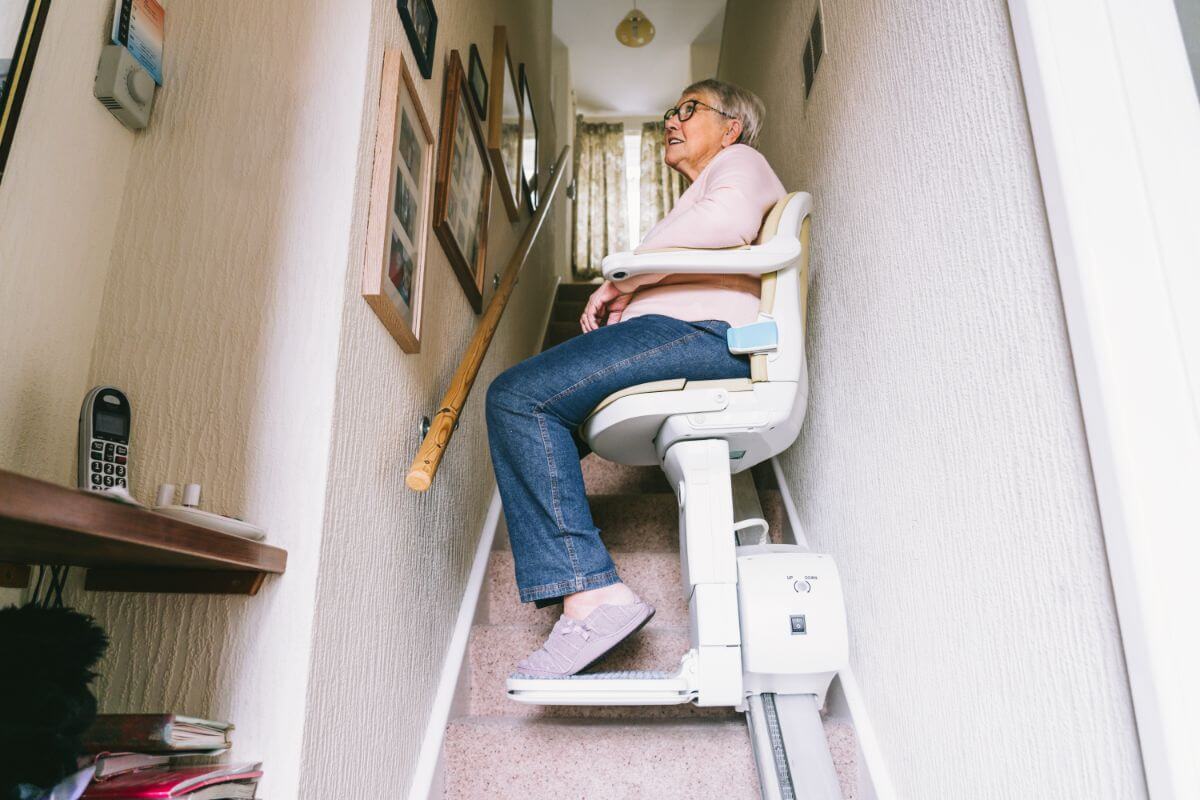

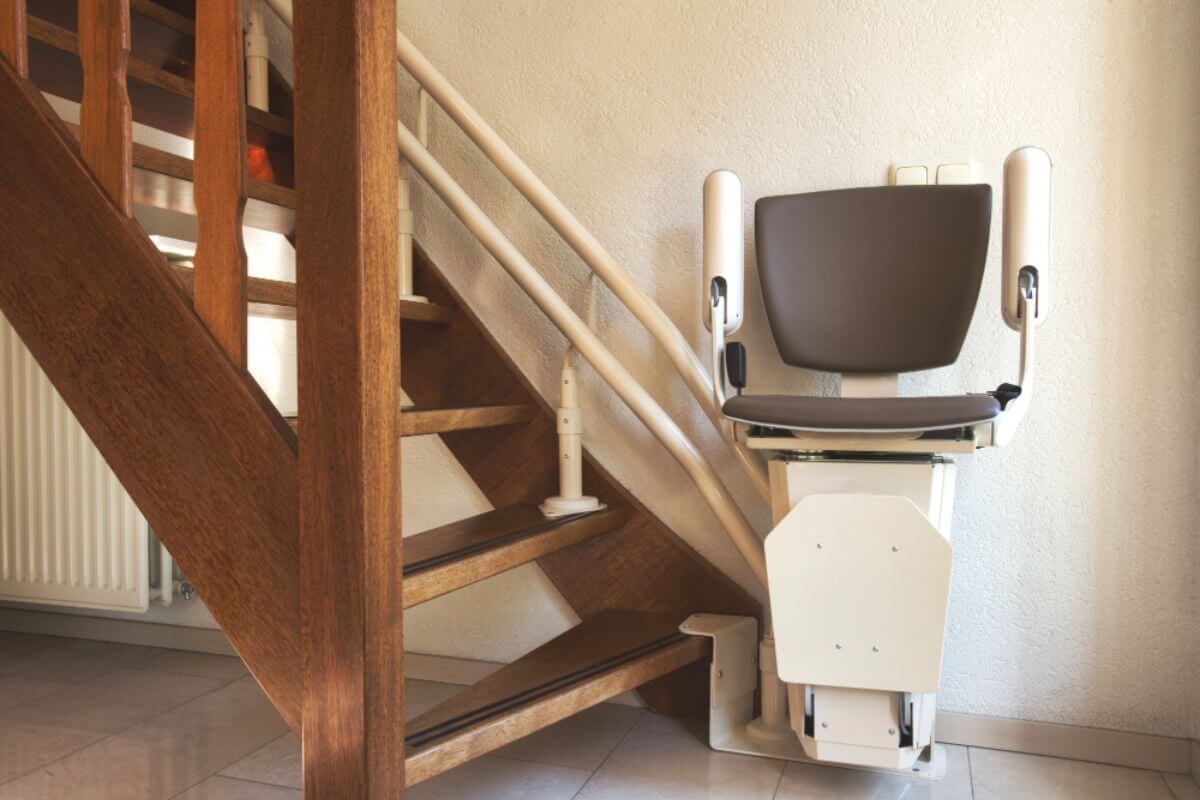
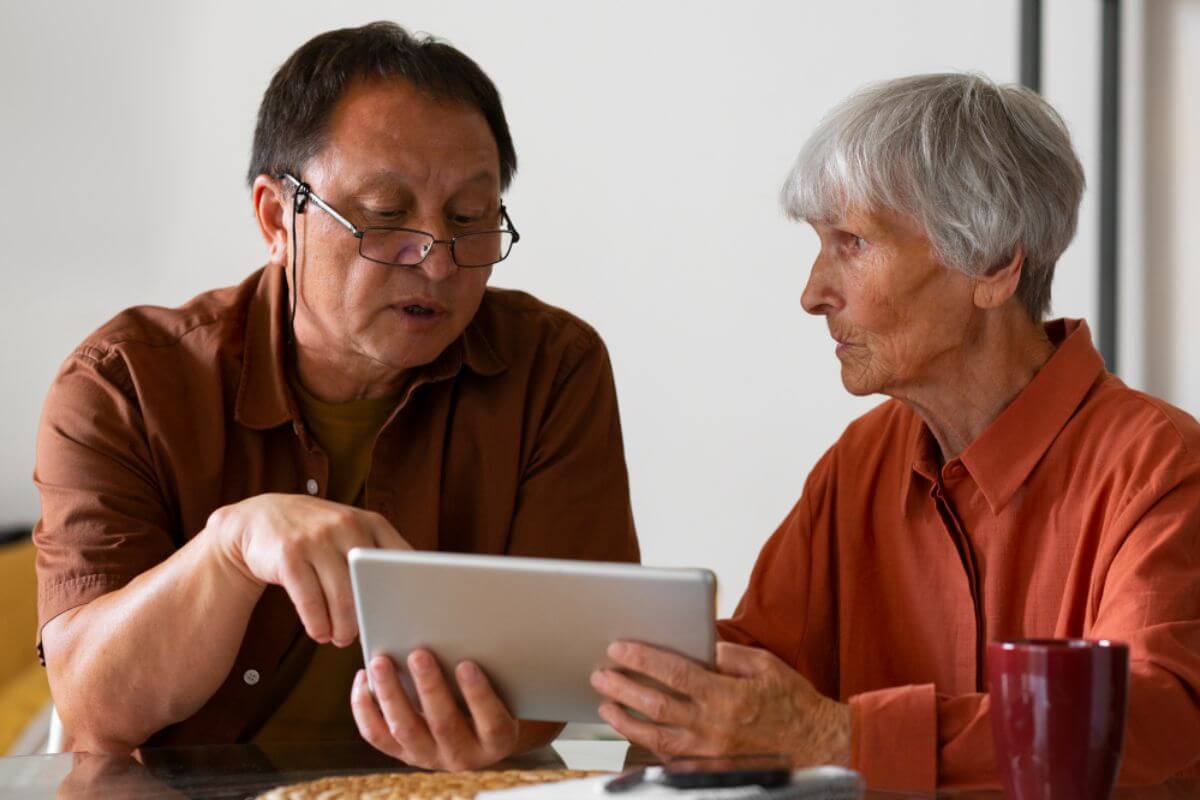
Leave a Comment
We'd Love to Hear Your Thoughts Got something to say? We're all ears! Leave your comments below and let us know what you think. Your feedback helps us improve and serve you better. Can't wait to hear from you!